Defenses to specific pe - Study guides, Class notes & Summaries
Looking for the best study guides, study notes and summaries about Defenses to specific pe? On this page you'll find 57 study documents about Defenses to specific pe.
Page 3 out of 57 results
Sort by
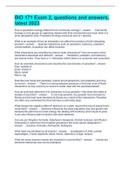
-
BIO 171 Exam 2, questions and answers, latest 2023
- Exam (elaborations) • 9 pages • 2023
-
Available in package deal
-
- $11.49
- + learn more
BIO 171 Exam 2, questions and answers, latest 2023 How is population ecology different from community ecology? Community Ecology is how groups of organisms interact with their environment and each other in a given geographic area. Population Ecology would just look at 1 species What is an example of how an interaction can affect the evolution of both interacting species? Species interactions such as parasitism, herbivory, predation, commensalism, mutualism can affect evolution W...
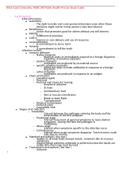
-
West Coast University: NURS 340 Public Health Proctor Study Guide,100% CORRECT
- Exam (elaborations) • 37 pages • 2023
-
- $15.99
- + learn more
West Coast University: NURS 340 Public Health Proctor Study Guide - Fundamentals o Ethical Principles ▪ Autonomy • The right to make one's own personal decisions even when those decisions might not be in that person's own best interest ▪ Beneficence • Action that promotes good for others without any self interest ▪ Fidelity • fulfillment of promises ▪ Justice • Fairness in care delivery and use of resources ▪ nonmaleficence • A commitment to do no harm ▪ ...
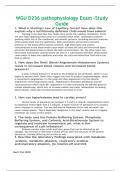
-
WGU Pathophysiology Study Guide: D236 Pathophysiology
- Exam (elaborations) • 25 pages • 2023
-
- $9.49
- + learn more
WGU Pathophysiology Study Guide: D236 Pathophysiology Lesson 1 TO Lesson 11 WGU Pathophysiology Study Guide: D236 Pathophysiology Lesson 1 TO Lesson 11: Pathophysiology Remediation Lesson 1: Homeostasis Concepts 1. Starling's Law of Capillary forces is the force behind the movements of fluid in capillary beds throughout the body. The two forces at work are hydrostatic and osmotic pressures. Homeostasis is achieved when these two forces are equal in the capillary- cell interfaces. When the hydro...
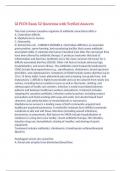
-
GI PCCN Exam 52 Questions with Verified Answers,100% CORRECT
- Exam (elaborations) • 28 pages • 2024
-
- $10.99
- + learn more
GI PCCN Exam 52 Questions with Verified Answers The most common causative organism of antibiotic-associated colitis is A. Clostridium difficile. B. Staphylococcus aureus. C. Salmonella. D. Escherichia coli. - CORRECT ANSWER A. Clostridium difficile is an anaerobic gram-positive, spore-forming, toxin-producing bacillus that causes antibiotic-associated colitis. It colonizes the human intestinal tract after the normal gut flora have been altered by antibiotic therapy. It produces exotoxins ...
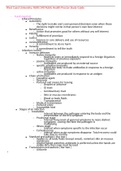
-
West Coast University: NURS 340 Public Health Proctor Study Guide,100% CORRECT
- Exam (elaborations) • 37 pages • 2023
-
- $15.99
- + learn more
West Coast University: NURS 340 Public Health Proctor Study Guide - Fundamentals o Ethical Principles ▪ Autonomy • The right to make one's own personal decisions even when those decisions might not be in that person's own best interest ▪ Beneficence • Action that promotes good for others without any self interest ▪ Fidelity • fulfillment of promises ▪ Justice • Fairness in care delivery and use of resources ▪ nonmaleficence • A commitment to do no harm ▪ ...
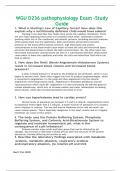
-
WGU Pathophysiology Study Guide: D236 Pathophysiology
- Exam (elaborations) • 25 pages • 2023
-
- $9.49
- + learn more
WGU Pathophysiology Study Guide: D236 Pathophysiology Lesson 1 TO Lesson 11 WGU Pathophysiology Study Guide: D236 Pathophysiology Lesson 1 TO Lesson 11: Pathophysiology Remediation Lesson 1: Homeostasis Concepts 1. Starling's Law of Capillary forces is the force behind the movements of fluid in capillary beds throughout the body. The two forces at work are hydrostatic and osmotic pressures. Homeostasis is achieved when these two forces are equal in the capillary- cell interfaces. When the hydro...
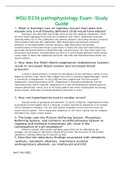
-
WGU Pathophysiology Study Guide: D236 Pathophysiology
- Exam (elaborations) • 25 pages • 2022
-
- $9.99
- + learn more
WGU Pathophysiology Study Guide: D236 Pathophysiology Lesson 1 TO Lesson 11 WGU Pathophysiology Study Guide: D236 Pathophysiology Lesson 1 TO Lesson 11: Pathophysiology Remediation Lesson 1: Homeostasis Concepts 1. Starling's Law of Capillary forces is the force behind the movements of fluid in capillary beds throughout the body. The two forces at work are hydrostatic and osmotic pressures. Homeostasis is achieved when these two forces are equal in the capillary- cell interfaces. When the hydro...
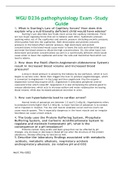
-
WGU Pathophysiology Study Guide: D236 Pathophysiology
- Exam (elaborations) • 25 pages • 2022
-
- $14.99
- + learn more
WGU Pathophysiology Study Guide: D236 Pathophysiology Lesson 1 TO Lesson 11 WGU Pathophysiology Study Guide: D236 Pathophysiology Lesson 1 TO Lesson 11: Pathophysiology Remediation Lesson 1: Homeostasis Concepts 1. Starling's Law of Capillary forces is the force behind the movements of fluid in capillary beds throughout the body. The two forces at work are hydrostatic and osmotic pressures. Homeostasis is achieved when these two forces are equal in the capillary- cell interfaces. When the hydro...
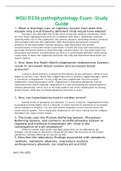
-
WGU Pathophysiology Study Guide: D236 Pathophysiology
- Exam (elaborations) • 25 pages • 2022
-
- $19.99
- + learn more
WGU Pathophysiology Study Guide: D236 Pathophysiology Lesson 1 TO Lesson 11 WGU Pathophysiology Study Guide: D236 Pathophysiology Lesson 1 TO Lesson 11: Pathophysiology Remediation Lesson 1: Homeostasis Concepts 1. Starling's Law of Capillary forces is the force behind the movements of fluid in capillary beds throughout the body. The two forces at work are hydrostatic and osmotic pressures. Homeostasis is achieved when these two forces are equal in the capillary- cell interfaces. When the hydro...
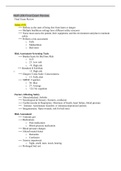
-
NUR 209 Final Exam Review.
- Exam (elaborations) • 61 pages • 2022
-
- $15.49
- + learn more
NUR 209 Final Exam Review. Final Exam Review Safety (9/5) ⟶ Defines as the state of being free from harm or danger ⟶ Multiple healthcare settings have different safety concerns ⟶ Nurse must assess the patient, their equipment, and the environment and plan to maintain safety ⟶ Perform a risk assessment o Falls o Malnutrition o Bed sores Risk Assessment Screening Tools ⟶ Braden Scale for Bed Sore Risk o 0-23 o 23: Low risk o <9: High risk ⟶ Hendrich II Fall Risk ...

How did he do that? By selling his study resources on Stuvia. Try it yourself! Discover all about earning on Stuvia


